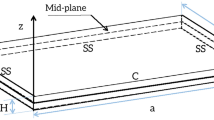Abstract
This paper deals with the solution of modified-Duffing ordinary differential equation for large-amplitude vibrations of imperfect circular plate. Four types of boundary conditions are considered as well as viscous damping. Lindstedt’s perturbation technique and Runge–Kutta method are applied. The solution from two methods are plotted and compared for a validity check. Lindstedt’s perturbation technique is proved to be accurate for sufficiently small vibration amplitude and imperfection. The results from Runge–Kutta method is plotted to form a backbone curve except for the case with clamped and zero radial stress boundary condition. Instead of expected softening–hardening process, the curve is only softening thus no longer backbone. More importantly, a dynamic failure is noticed when initial vibration amplitude grows under this boundary condition. A geometric imperfection will further help to trigger this failure at a smaller amplitude. This finding has served a new way to judge dynamic failure mode and is valuable for structure design concerning vibration.





Similar content being viewed by others
References
Mallikarjuna TK (1993) A critical review and some results of recently developed refined theories of fiber-reinforced laminated composites and sandwiches. Compos Struct 23(4):293–312. doi:10.1016/0263-8223(93)90230-N
Kang MK, Huang R, Knowles T (2006) Torsional vibrations of circular elastic plates with thickness steps. IEEE Trans Ultrasonic Ferroelectr Freq Control 53(2). doi:10.1109/TUFFC.2006.1593373
Najafov AM, Sofiyev AH, Hui D, Kadioglu F, Dorofeyskaya NV, Huang H (2014) Non-linear dynamic response of symmetric and antisymmetric cross-ply laminated orthotropic thin shells. Meccanica 49:413–427. doi:10.1007/s11012-013-9802-z
Yamaki N (1961) Influence of large amplitudes on flexural vibrations of elastic plates. ZAMM 41:501–510
Hui D (1983) Large amplitude axisymmetric vibrations of geometrically imperfect circular plates. J Sound Vib 91:239–246. doi:10.1016/0022-460X(83)90899-4
Hui D (1983) Large amplitude vibrations of geometrically imperfect shallow spherical shells with structural damping. AIAA J 21(12):1736–1741. doi:10.2514/3.8317
Hui D (1984) Effects of geometric imperfections on large amplitude vibrations of rectangular plates with hysteresis damping. ASME J Appl Mech 51(1):216–220. doi:10.1115/1.3167582
Hui D (1985) Soft-spring nonlinear vibrations of antisymmetrically laminated rectangular plates. Int J Mech Sci 27:397–408. doi:10.1016/0020-7403(85)90030-X
Hui D (1990) Accurate backbone curves for a modified duffing equation for vibrations of imperfect structures with viscous damping. J Vib Acoust 112:304–311. doi:10.1115/1.2930509
Lindstedt A, Akad AK (1882) Wiss. St. Petersburg 31, no. 4
Pirbodaghi T, Hoseini SH, Ahmadian MT, Farrahi GH (2009) Duffing equations with cubic and quintic nonlinearities. Comput Math Appl 57(3):500–506. doi:10.1016/j.camwa.2008.10.082
Elías-Zúñiga Alex (2013) Exact solution of the cubic quintic duffing oscillator. Appl Math Model 37(4):2574–2579. doi:10.1016/j.apm.2012.04.005
Huang He, Hui David (2015) Accurate backbone curves for large-amplitude vibrations of imperfect rectangular plate with viscous damping. KSCE. doi:10.1007/s12205-015-0114-9
Gonçalves PB, Del Prado ZJGN (2002) Nonlinear oscillations and stability of parametrically excited cylindrical shells. Meccanica 37(6):569–597. doi:10.1023/A:1020972109600
Bauer HF (1968) Nonlinear response of elastic plates to pulse excitations. J Appl Mech 35(1). doi:10.1115/1.3601172
Author information
Authors and Affiliations
Corresponding author
Appendix: Lindstedt’s perturbation solution to Duffing equation with a quadratic term
Appendix: Lindstedt’s perturbation solution to Duffing equation with a quadratic term
The second order non-linear Duffing ordinary differential equation is
By changing the variable, \( \uptau = {{\Omega}}{\rm t} \), Eq. (30) will turn into
The periodic solution \( {\text{w}}\left( {\uptau} \right) \) and the associated frequency are assumed to be of the forms
Furthermore, the non-linear terms in Eq. (31) are also expanded in a power series in \( \upepsilon \). Equating terms incolving \( \upepsilon^0 \), \( \upepsilon \), and \( \upepsilon^2 \) and dividing through by \( k \) (defined to be \( {{\Omega }}_{0}^{2} \)), one obtains
and the initial conditions are
The solution of Eq. (34) is
Substituting \( {\text{w}}_{0} \left( {\uptau} \right) \) into Eq. (35), one obtains
In order to avoid secular terms, the coefficient of \( { \cos }\left( {\uptau} \right) \) is set to zero so that
Accordingly, the solution to the differential equation for \( {\text{w}}_{1} \left( {\uptau} \right) \) is
Finally, substituting the known forms for \( {\text{w}}_{0} \left( {\uptau} \right) \), \( {\text{w}}_{1} \left( {\uptau} \right) \) and \( {{\Omega }}_{1} \) into equation 35, one obtains
doneAgain, setting the coefficient of \( { \cos }\left( {\uptau} \right) \) to zero yields
Furthermore, the solution to the differential equation for \( {\text{w}}_{2} \left( {\uptau} \right) \) is
The solution is obtained by assembling \( {\text{w}}_{0} \left( {\uptau} \right) \), \( {\text{w}}_{0} \left( {\uptau} \right) \) and \( {\text{w}}_{0} \left( {\uptau} \right) \) in Eq. (32) and replacing \( \uptau \) by \( {{\Omega t}} + {{\upvarphi }} \). Thus, for a given set of initial conditions \( {\text{w}}\left( {{\text{t}} = 0} \right) \) and \( {\text{w}},_{\text{t}} \left( {{\text{t}} = 0} \right) \), the value of the amplitude A and the phase angle \( {{\upvarphi }} \) can be found. Finally, substituting \( {{\Omega }}_{1} \) and \( {{\Omega }}_{2} \) into Eq. (33) shows that the ratio of the non-linear frequency to the linear frequency is related to the vibration amplitude by
Rights and permissions
About this article
Cite this article
Huang, H., Hui, D. Accurate backbone curves and dynamic failure for large-amplitude axisymmetric vibrations of imperfect circular plates. Meccanica 51, 559–567 (2016). https://doi.org/10.1007/s11012-015-0223-z
Received:
Accepted:
Published:
Issue Date:
DOI: https://doi.org/10.1007/s11012-015-0223-z



